Beef Rolls Unrolled: Your Ultimate Guide to Stuffed, Savory Perfection
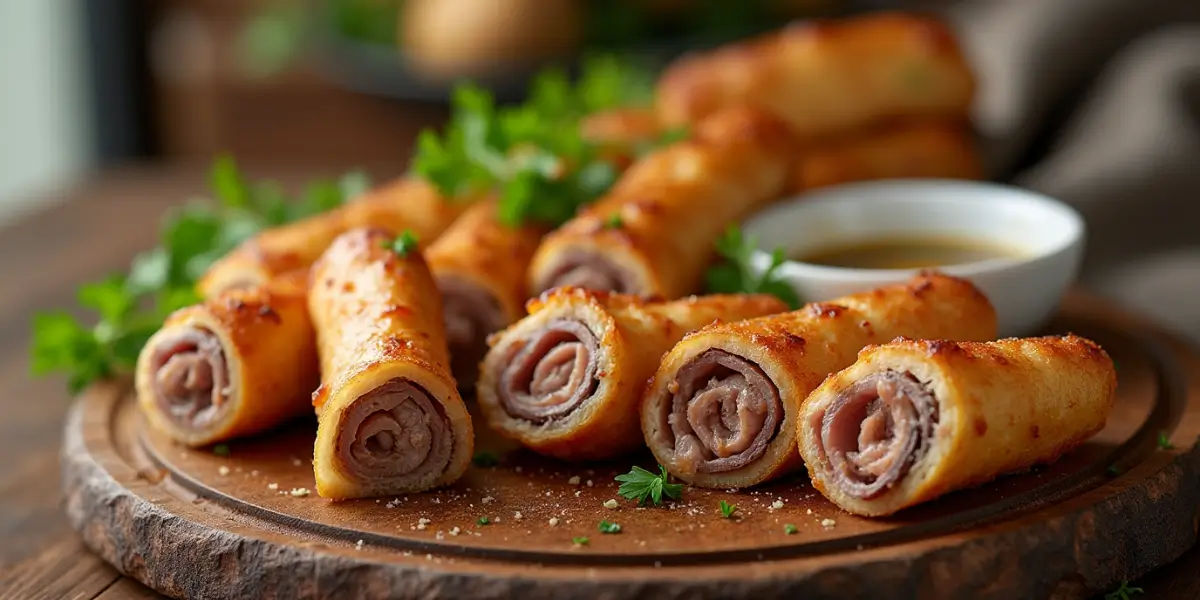
Remember that feeling? Walking into a kitchen filled with the warm, rich, deeply comforting aroma of something savory simmering away? It’s the scent of home, of celebration, of pure culinary satisfaction. For many of us, beef rolls embody that feeling perfectly. Imagine tender, thin slices of beef, lovingly wrapped around a symphony of flavorful fillings – maybe smoky bacon, tangy pickles, and mustard, or perhaps vibrant spinach and creamy cheese. Slowly braised until melt-in-your-mouth tender, bathed in a luxurious gravy… it’s not just dinner; it’s an experience. Whether you call them Rouladen, Braciole, or simply glorious beef rolls, these culinary parcels offer elegance and homely comfort in every bite. Intrigued? Let’s unravel the delicious secrets of making perfect beef rolls right in your own kitchen.
What Exactly Are Beef Rolls? (Beyond the Name!)
At its heart, the concept of beef rolls is beautifully simple, yet endlessly adaptable. It’s about transformation – taking humble ingredients and turning them into something extraordinary.
- The Core Concept: Thin Beef + Flavorful Filling = Magic: The foundation is thin slices of beef. These act as a canvas, pounded slightly for even cooking and easier rolling. Onto this canvas goes your chosen filling – a layer of flavor that infuses the meat as it cooks. The roll is then secured (often with toothpicks or kitchen twine) and cooked, typically using moist heat methods like braising. This slow cooking breaks down the beef’s connective tissue, resulting in incredible tenderness, while the filling melds and intensifies. The pan drippings? They become the base for a rich, essential sauce or gravy. It’s a perfect culinary equation: structure + flavor + slow cooking = succulent beef roll perfection.
- Global Inspiration: From German Rouladen to Italian Braciole: Beef rolls are a testament to culinary ingenuity found worldwide. The German Rouladen is perhaps the most iconic – featuring thinly sliced beef (traditionally top round) spread with mustard, layered with bacon, onions, and pickles (gherkins), then braised in a dark, flavorful gravy. Journey south to Italy, and you’ll find Braciole (or Involtini). Often using thinner cuts like flank steak or even slices of pork or veal, Italian beef rolls might feature a filling of breadcrumbs, cheese (like Pecorino or Parmesan), garlic, parsley, raisins, and pine nuts, simmered in a vibrant tomato sauce. Simpler beef pinwheels or roll-ups, often baked and featuring cheese and spinach, are popular American weeknight variations. Each culture brings its unique flavors to this versatile technique.
- Why You’ll Love Making (and Eating!) Beef Rolls: Beyond the incredible taste, there are compelling reasons to embrace beef rolls:
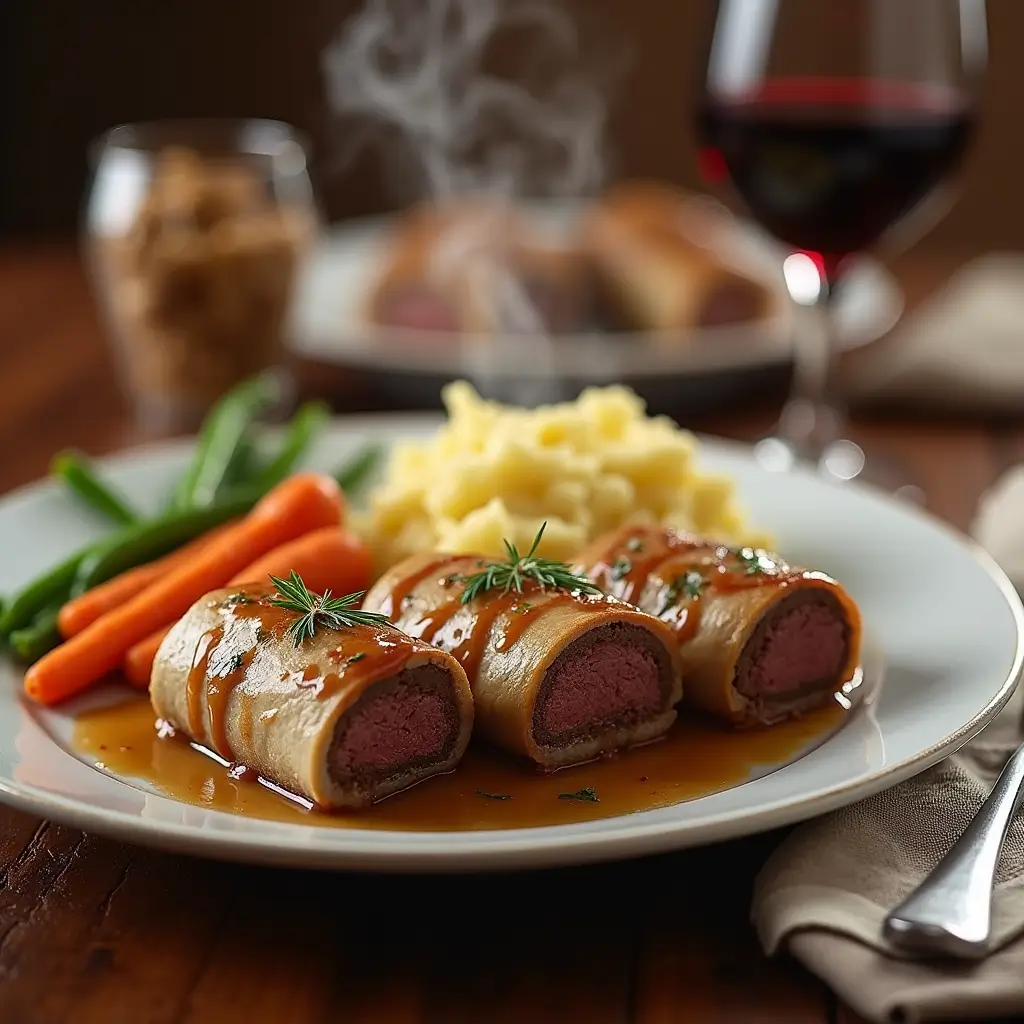
- Comfort Food Elevated: They deliver deep, satisfying flavors associated with slow-cooked classics.
- Impressive Yet Approachable: They look fancy but the technique is straightforward. Perfect for dinner parties.
- Meal Prep Friendly: They often taste even better the next day as flavors meld. Great for leftovers.
- Versatility is Key: Endless filling and sauce combinations mean you’ll never get bored.
- Economical Magic: Using less expensive, thinner cuts of beef transforms them into something luxurious through slow cooking. Making beef rolls is a rewarding culinary adventure.
Gathering Your Arsenal: Ingredients & Essential Tools
Success with beef rolls starts with selecting the right components and having a few key tools handy.
- Choosing the Perfect Cut of Beef for Rolls (Key to Tenderness!): The ideal cut needs to be relatively lean, have a good grain for slicing thinly across (to shorten fibers for tenderness), and be pliable enough to roll. Avoid cuts with excessive marbling or thick connective tissue within the slice itself.
- Top Round (Inside Round): The gold standard for traditional German Rouladen. It’s lean, slices beautifully thin, and braises superbly. Ask your butcher to slice it thinly (about 1/4 inch or 6mm) across the grain.Bottom Round (Outside Round): Similar to top round but can be slightly tougher. Excellent when sliced very thinly and pounded well.Sirloin Tip (Knuckle): Another lean, affordable option suitable for thin slicing. Often slightly more tender than bottom round.Flank Steak: A popular choice for Italian Braciole or pinwheels. It’s naturally thin but requires careful slicing with the grain into wide strips before rolling against the grain. Benefits significantly from pounding.Avoid: Ribeye, New York Strip, Chuck Roast (as a whole roast – chuck can be sliced thinly for rolls, but it’s less common and has more internal marbling/fat). Pre-sliced “stir-fry” beef can sometimes work in a pinch for smaller rolls but varies greatly in thickness and quality.
- Filling Fantasia: Classic & Creative Ideas for Your Beef Rolls: This is where your creativity shines! Fillings add moisture, flavor, and texture contrast.The German Rouladen Trinity: Yellow mustard, thinly sliced bacon (Speck), chopped onions, sliced dill pickles (gherkins). Simple, tangy, smoky perfection.Italian Braciole Staples: Breadcrumbs (fresh or dried), grated Pecorino or Parmesan cheese, minced garlic, chopped fresh parsley, sometimes raisins, pine nuts, prosciutto, or hard-boiled egg. Bound with a little olive oil or egg.American Pinwheel Favorites: Cream cheese or ricotta mixed with spinach (thawed and squeezed dry), sun-dried tomatoes, shredded mozzarella or provolone, herbs.Endless Creative Twists:Mushroom & Gruyère: Sautéed mushrooms, caramelized onions, Gruyère cheese.Mediterranean: Spinach, feta cheese, kalamata olives, lemon zest.Provençal: Herbes de Provence, Dijon mustard, caramelized onions, maybe a little goat cheese.Spicy Kick: Pepper jack cheese, jalapeños, corn, black beans.Simple & Savory: Just a generous smear of grainy mustard and a sprinkle of fresh herbs.Table 2: Classic vs. Creative Beef Roll FillingsStyleCore Filling ComponentsFlavor ProfileSauce Pairing SuggestionGerman ClassicYellow mustard, bacon slices, chopped onion, dill pickle slicesTangy, Smoky, SavoryRich Brown Gravy (Rouladen Sauce)Italian ClassicBreadcrumbs, Pecorino/Parmesan, garlic, parsley (+/- raisins, pine nuts, prosciutto)Savory, Herby, Nutty (optional)Tomato SauceSpinach & CheeseCream cheese/Ricotta, cooked spinach (squeezed dry), mozzarella/provolone, garlicCreamy, Cheesy, EarthySimple Pan Sauce or TomatoMushroom GruyèreSautéed mushrooms, caramelized onions, Gruyère cheese, thymeEarthy, Sweet Onion, Rich CheeseRed Wine Pan SauceSpicy SouthwestPepper jack cheese, diced jalapeños, corn, black beans, cuminCheesy, Spicy, Smoky, Sweet CornEnchilada Sauce or Salsa Cream
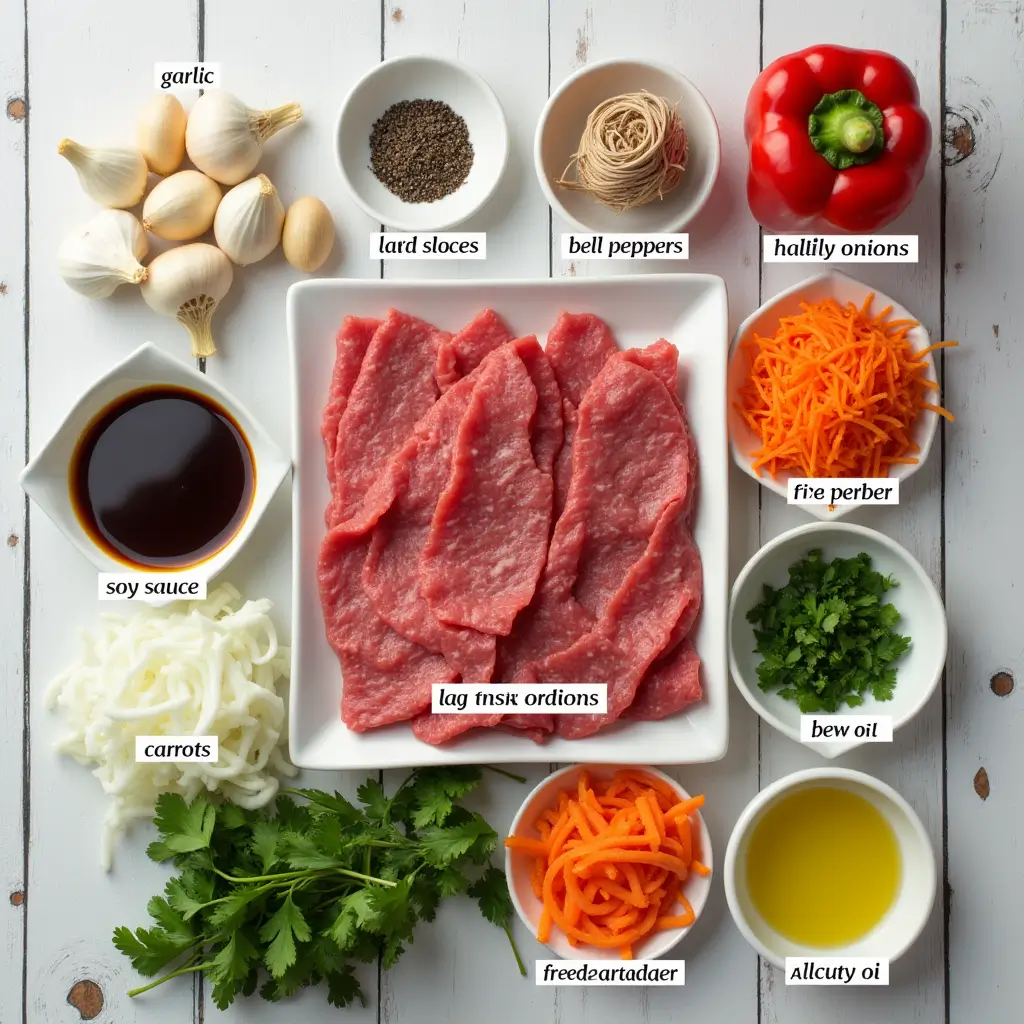
- Must-Have Kitchen Tools for Effortless Beef Roll Prep: You likely have most of these already!
- Sharp Knife: For trimming beef and prepping fillings.
- Meat Mallet/Tenderizer: Crucial for pounding slices to an even thickness (about 1/8 inch or 3mm) for consistent cooking and easy rolling. Use the flat side. Place meat between plastic wrap or in a zip-top bag to prevent splatter.
- Cutting Board: A large, stable one.
- Toothpicks or Kitchen Twine: Essential for securing the rolls so they don’t unravel during cooking. Soak wooden toothpicks in water for 10 minutes first to prevent burning. Twine is more secure for larger rolls.
- Large Skillet/Dutch Oven: Heavy-bottomed and oven-safe (if finishing in the oven). Needs a tight-fitting lid for braising. Stainless steel or enameled cast iron are ideal.
- Tongs: Gentle handling of rolls when searing and turning.
- Wooden Spoon/Spatula: For stirring the sauce base and scraping up browned bits (fond).
- Instant-Read Thermometer (Optional but Recommended): To ensure beef reaches a safe internal temperature (minimum 145°F / 63°C for medium-rare, but for braised rolls, they usually go much higher, around 180-200°F / 82-93°C, for full tenderness).
Mastering the Art: Your Step-by-Step Beef Roll Guide
Now for the fun part! Let’s transform those ingredients into stunning beef rolls.
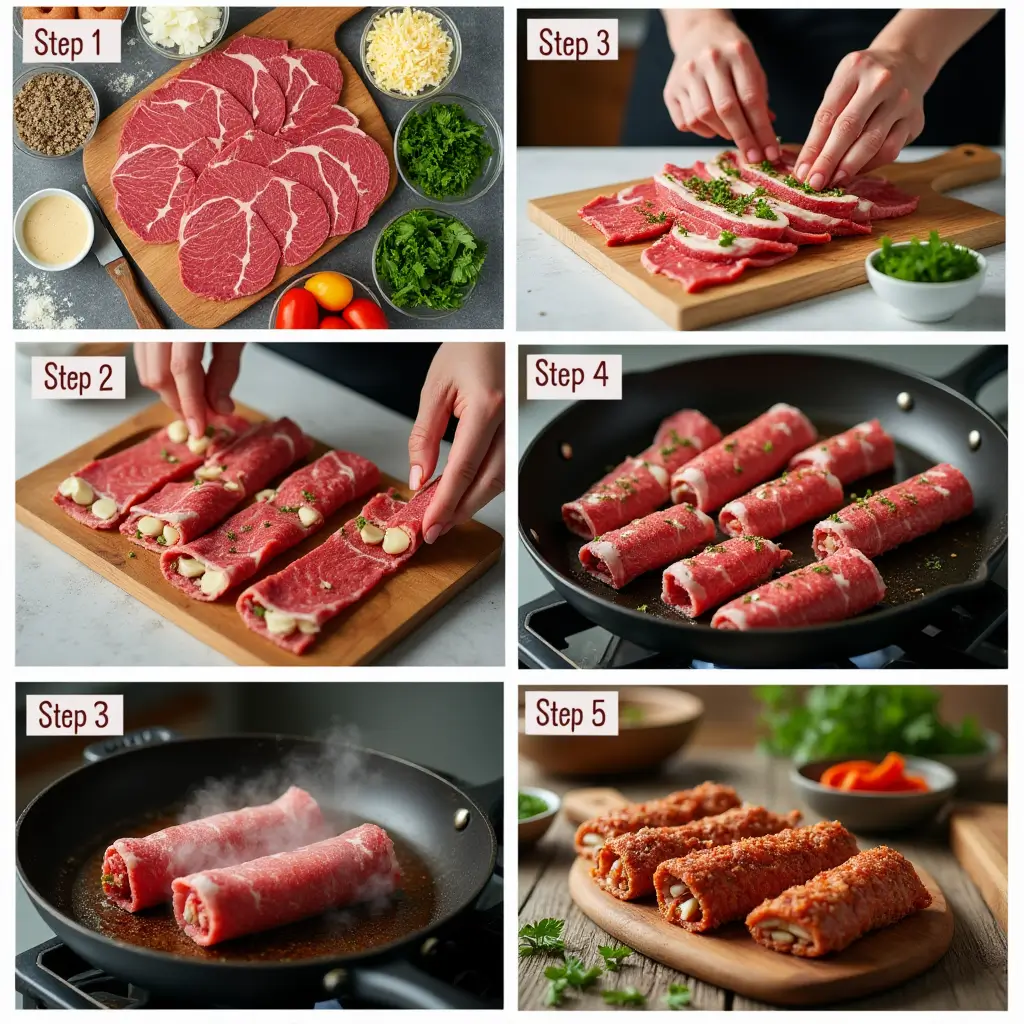
- Prep Like a Pro: Slicing, Pounding, and Filling Assembly:
- Slice & Trim: If not pre-sliced, place your slightly chilled beef on a cutting board. Slice across the grain into pieces roughly 4-6 inches long and 3-4 inches wide (adjust based on cut). Trim any large pieces of fat or silverskin.
- Pound to Perfection: Place one slice between two sheets of plastic wrap or inside a large zip-top bag (leave open). Using the flat side of your meat mallet, gently but firmly pound outwards from the center towards the edges. Aim for an even thickness of about 1/8 inch. Be careful not to tear the meat. Repeat for all slices. Season lightly with salt and pepper on one side.
- Spread & Layer: Lay a pounded slice seasoned-side down (the inside of the roll). Spread your chosen “glue” thinly over the surface – mustard is classic for German, or a little oil/mustard for others. Leaving a small border (about 1/2 inch), layer your filling ingredients evenly over the beef. Don’t overfill! Start near one short end.
- Tight Roll & Secure: Starting from the filling end, tightly roll up the beef slice, enclosing the filling. Secure the seam and ends with 2-3 toothpicks (insert parallel to the seam) or tie securely with kitchen twine in 2-3 places. Repeat for all rolls. Pat them dry with paper towel – this ensures a better sear.
- Searing & Simmering: Cooking Methods for Perfect Beef Rolls:
- Sear for Flavor: Heat 1-2 tablespoons of oil (or a mix of oil and butter) in your heavy skillet/Dutch oven over medium-high heat. When hot and shimmering, carefully add the beef rolls (don’t crowd the pan; work in batches if needed). Sear on all sides until deeply browned, about 2-3 minutes per side. This step is non-negotiable for building flavor in the sauce! Remove rolls to a plate.
- Soffritto & Deglaze: Lower heat to medium. Add aromatic vegetables like chopped onions, carrots, and celery (a “soffritto” or “mirepoix”) to the pan drippings. Sauté for 5-7 minutes until softened. Stir in minced garlic for the last minute. Pour in your deglazing liquid – red wine, beef broth, or even water (about 1/2 cup). Scrape vigorously with a wooden spoon to lift all the delicious browned bits (fond) from the bottom of the pan. This is flavor gold!
- Braise to Bliss: Return the seared beef rolls and any accumulated juices to the pot. Pour in enough hot beef broth (or broth mixed with tomato sauce/paste/water) to come about halfway up the sides of the rolls. Add bay leaves, peppercorns, or other desired herbs. Bring the liquid to a gentle simmer. Cover the pot tightly with the lid. Reduce heat to low, maintaining a bare simmer. Alternatively, place the covered pot in a preheated 325°F (160°C) oven. Braise for 1.5 to 2.5 hours, depending on the thickness of your rolls and the cut of beef. The beef should be fork-tender. Check occasionally, adding a little more liquid if needed.
- Sauce Sensation: Building a Rich Gravy from the Pan Drippings: Don’t waste that incredible braising liquid!
- Remove Rolls: Once the beef rolls are tender, carefully remove them to a platter using tongs. Tent loosely with foil to keep warm. Remove toothpicks or twine.
- Strain & Thicken (Optional): Strain the braising liquid through a fine-mesh sieve into a bowl or gravy separator to remove solids. Skim off excess fat from the surface. Return the liquid to the pot.
- Reduce & Enrich: Bring the liquid to a simmer over medium heat. Let it reduce slightly to concentrate flavors. If a thicker gravy is desired, you have options:
- Slurry: Mix 1 tablespoon cornstarch with 2 tablespoons cold water. Whisk this slurry into the simmering liquid. Cook for 1-2 minutes until thickened and glossy.
- Beurre Manié: Mash equal parts (e.g., 1 tbsp each) soft butter and flour into a paste. Whisk small bits into the simmering liquid until incorporated and thickened.
- Reduction: Simply simmer longer until reduced to your desired consistency.
- Season & Serve: Taste the sauce! Season generously with salt and freshly ground black pepper. A splash of red wine vinegar, a knob of butter, or a spoonful of sour cream (for Rouladen-style) can add wonderful depth and richness. Pour the luscious sauce over the waiting beef rolls.
Beef Roll Brilliance: Variations, Tips & Serving Suggestions
Your journey into the world of beef rolls doesn’t stop at the first batch!
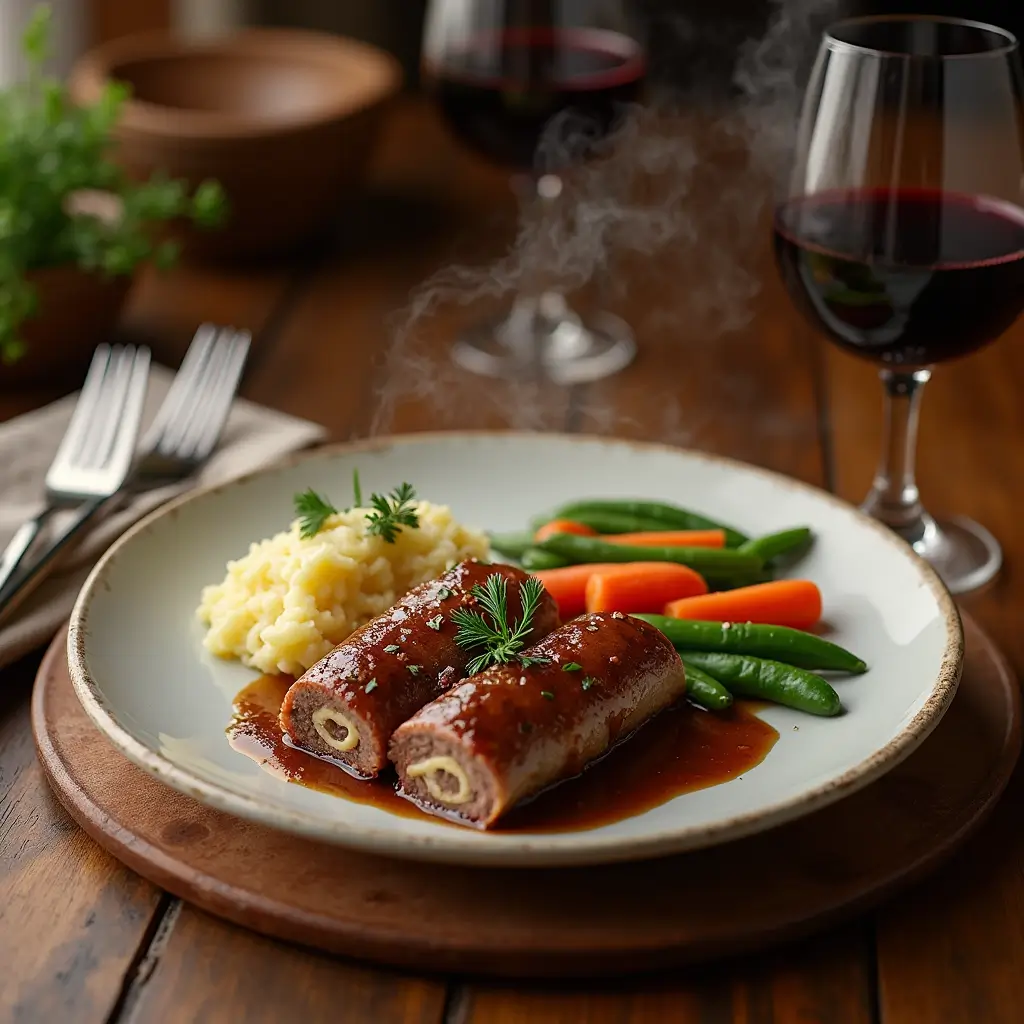
- Global Twists: Exploring Different Beef Roll Traditions: Embrace the world tour!
- Rouladen Authenticity: Stick to the German classic: top round, German mustard, bacon, onion, pickle. Braise in broth with a little tomato paste. Thicken sauce with sour cream at the end (Geschmorte Rouladen).
- Braciole Charm: Use flank steak or thin top round. Fill with breadcrumbs, Pecorino, garlic, parsley, pine nuts, raisins. Brown, then simmer in your best tomato sauce for 1.5-2 hours. Serve the rolls sliced or whole, smothered in sauce.
- Quick Pinwheel Win: Use flank steak sliced with the grain, pounded thin. Spread with cream cheese/spinach mixture or pesto and cheese. Roll tightly against the grain, secure, slice into 1-inch thick pinwheels. Sear pinwheels, then finish in a 375°F (190°C) oven for 15-20 minutes, or bake directly. Great for appetizers or quicker mains.
- Asian Fusion: Marinate thin slices briefly in soy, ginger, garlic. Fill with shiitake mushrooms, scallions, water chestnuts. Sear, then braise in a mix of broth, soy, mirin, and a touch of sesame oil. Thicken sauce slightly. Garnish with sesame seeds.
- Pro Tips for Flawless Beef Rolls Every Single Time:
- Chill for Rolling: Slightly chilled beef is easier to handle and slice/pound.
- Pound Evenly: Uniform thickness = uniform cooking. Avoid thin spots that tear.
- Season the Meat: Lightly salt and pepper the beef before adding filling.
- Don’t Overstuff: Too much filling makes rolling difficult and can cause bursting.
- Secure Tightly: Loose rolls unravel during cooking. Use enough toothpicks or tie well.
- Sear Hot & Fast: Get that deep brown crust – it’s packed with flavor.
- Deglaze Thoroughly: Don’t let that precious fond go to waste! Scrape the pan well.
- Low & Slow Simmer: A gentle braise is key to tenderizing the beef without toughening it. Boiling will make it tough.
- Check Tenderness: Pierce the thickest part of a roll with a fork. It should slide in and out with little resistance.
- Rest Before Serving: Let the rolls rest for 5-10 minutes tented with foil after removing twine/toothpicks. This lets juices redistribute.
- Skim the Fat: For a cleaner sauce, skim excess fat from the braising liquid before thickening.
- What to Serve With Beef Rolls (The Perfect Pairings): Beef rolls demand delicious companions!
- Starchy Comfort: Mashed potatoes (classic for Rouladen gravy!), buttered egg noodles, creamy polenta, spaetzle, or crusty bread for soaking up sauce are ideal.
- Vegetable Sides: Braised red cabbage (a Rouladen staple!), roasted root vegetables (carrots, parsnips), green beans almondine, simple steamed broccoli, or a crisp green salad balance the richness.
- Wine Pairing: A medium-bodied red like Pinot Noir, Merlot, or a German Spätburgunder complements the savory beef and rich sauces beautifully. For tomato-based Braciole, a Chianti works wonders.
Conclusion
From the comforting depths of a German kitchen to the sun-drenched hills of Italy, and onto your own dinner table, beef rolls offer a world of flavor wrapped in tender, succulent beef. They might seem intricate, but as you’ve seen, mastering the technique – choosing the right cut, pounding with care, crafting flavorful fillings, searing for depth, and braising to fall-apart tenderness – is an incredibly rewarding culinary skill. The result is a dish that’s simultaneously impressive and deeply satisfying, perfect for a cozy family meal or a dinner party centerpiece. Whether you stick to a cherished traditional recipe or embark on your own filling adventure, the possibilities are endless. So, gather your ingredients, grab your mallet, and embrace the delicious art of the beef roll. Your next unforgettable meal awaits!
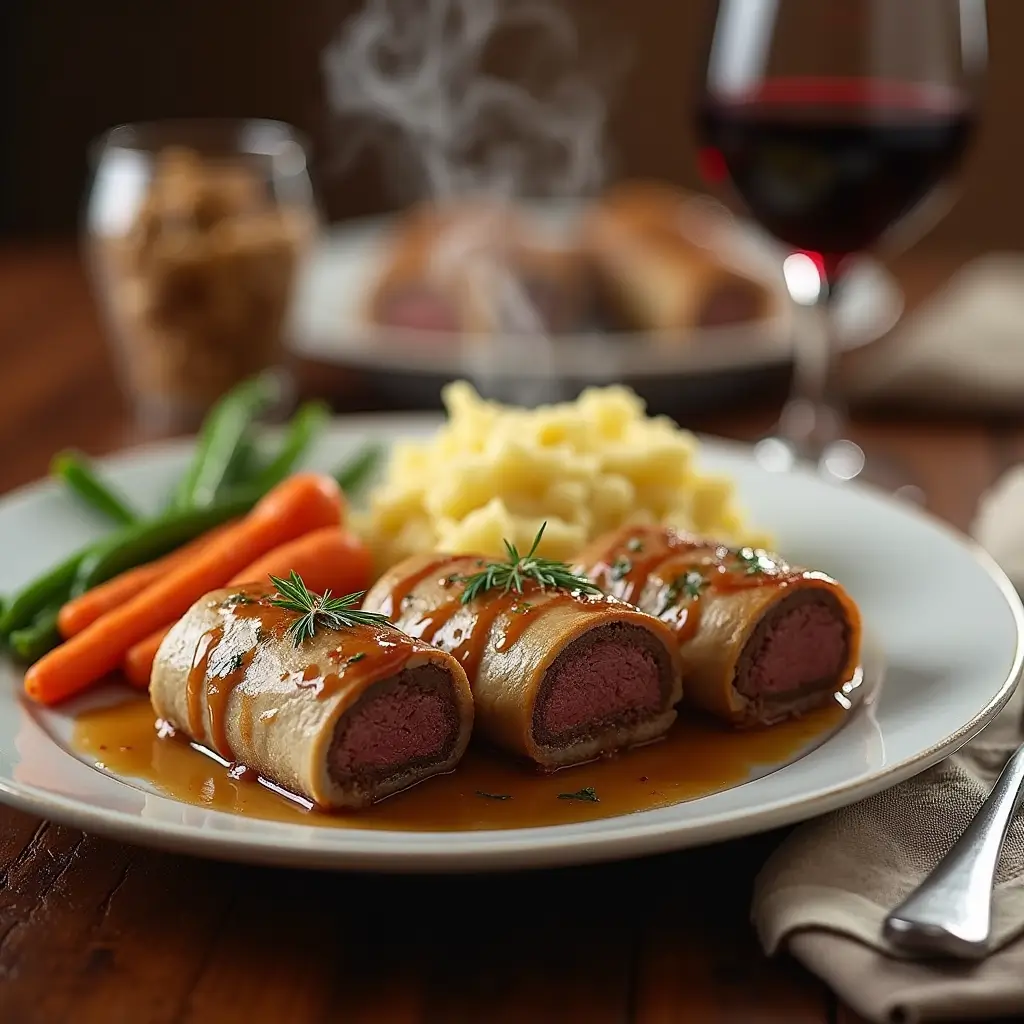
Ready to roll? Pick your favorite filling inspiration from this guide, head to the kitchen, and create your own batch of savory beef roll perfection! We’d love to hear about your culinary creations – share your favorite beef roll variations or tips in the comments below!
Frequently Asked Questions (FAQ) About Beef Rolls
- Q: What are beef rolls?
A: Beef rolls are a dish made by taking thin slices of beef, spreading them with flavorful ingredients (like mustard or cheese), adding a filling (such as bacon, onions, pickles, spinach, or breadcrumbs), rolling them up tightly, securing them, and then slowly braising or baking them until tender. They are often served with a rich sauce made from the cooking liquid. - Q: What’s the best cut of beef for making beef rolls?
A: The best cuts for beef rolls are lean and suitable for thin slicing and pounding, such as Top Round (ideal for traditional Rouladen), Bottom Round, Sirloin Tip, or Flank Steak (commonly used for Braciole or pinwheels). The key is slicing thinly across the grain (except for flank steak) and pounding for even cooking and easy rolling. See the table in the “Ingredients & Tools” section for a detailed comparison. - Q: Can I make beef rolls ahead of time?
A: Absolutely! Beef rolls are fantastic for making ahead. You have two great options:- Prep & Refrigerate: Assemble the rolls (slice, pound, fill, roll, secure) up to 24 hours in advance. Store covered in the fridge. Sear and braise when ready.
- Cook Completely & Reheat: Cook the beef rolls and sauce fully. Let cool, then store covered in the fridge for up to 3 days, or freeze for up to 3 months. Reheat gently on the stovetop or in a covered dish in the oven (325°F / 160°C) until warmed through, adding a splash of broth or water if the sauce thickens too much. Flavors often meld and improve overnight!
- Q: How do I prevent my beef rolls from falling apart during cooking?
A: Securing them properly is crucial! Use enough toothpicks (soaked in water first) inserted parallel to the seam, or tie them securely with kitchen twine in 2-3 places along the length. Also, ensure you don’t overfill them, as too much filling puts pressure on the seam. Finally, handle them gently with tongs when searing and transferring. - Q: Can I cook beef rolls in a slow cooker or Instant Pot?
A: Yes! Both are excellent methods for tender results.- Slow Cooker: Sear the rolls as directed. Place them in the slow cooker. Deglaze the pan and pour the liquid/aromatics over the rolls. Add enough broth to come about 1/3 to 1/2 way up the rolls. Cook on LOW for 6-8 hours or HIGH for 3-4 hours, until fork-tender. Thicken the sauce afterwards on the stovetop.
- Instant Pot: Use the Sauté function to sear rolls (in batches if needed). Remove. Deglaze pot, scraping fond. Add aromatics, sauté briefly. Return rolls. Add broth (max 1 cup for 6qt, 1.5 cups for 8qt – adjust based on recipe). Secure lid, set valve to Sealing. Cook on High Pressure for 45-60 minutes (depending on thickness). Natural Pressure Release for 15 minutes, then Quick Release. Remove rolls, thicken sauce using Sauté function.
Are You Try This Recipe ?
There are no reviews yet. Be the first one to write one.

